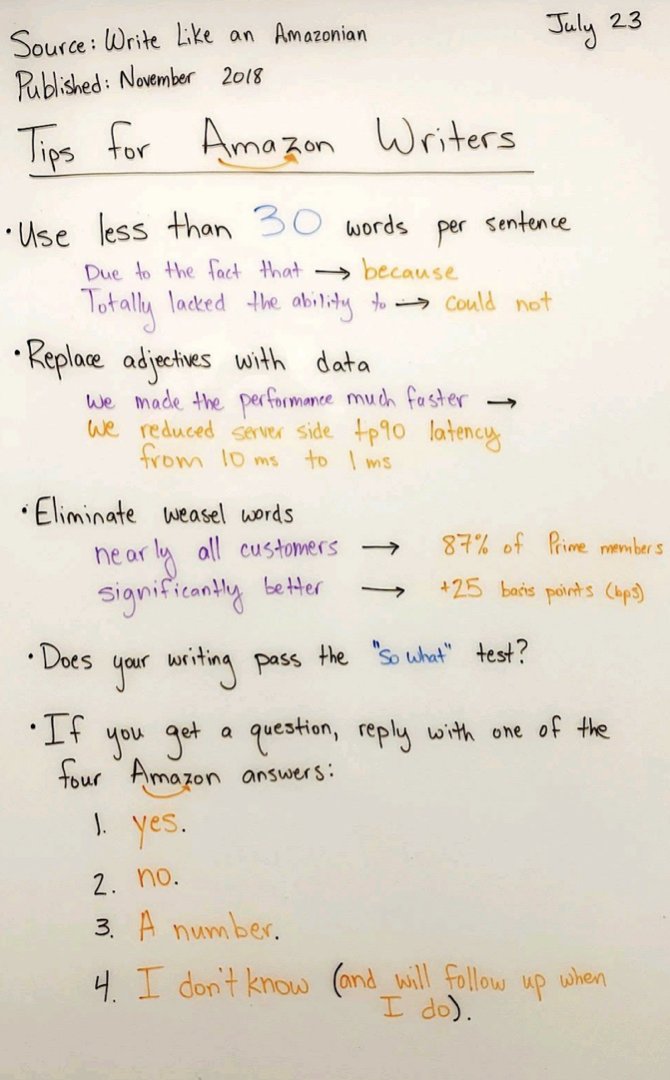
Dropbox went from 100k registered users in Sept 2008 to 4m registered users by Dec 2009.
Inspired by Paypal’s Refer-a-Friend program, Dropbox created a referral program so epic that it 2x its user base every 3 months for 15 months.
Here’s how they grew 3900% in 15 months 🧵
Inspired by Paypal’s Refer-a-Friend program, Dropbox created a referral program so epic that it 2x its user base every 3 months for 15 months.
Here’s how they grew 3900% in 15 months 🧵
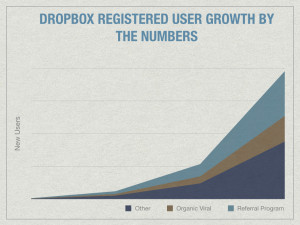
First, when I say an epic referral program, I mean it.
Look at these numbers:
- Sept 08: 100k registered users
- Dec 09: 4M registered users
- Sept 2017: 33.9M users, 10b valuation, +1B in rev.
According to the founder, Drew Houston, referrals increased signups by 60%.
Look at these numbers:
- Sept 08: 100k registered users
- Dec 09: 4M registered users
- Sept 2017: 33.9M users, 10b valuation, +1B in rev.
According to the founder, Drew Houston, referrals increased signups by 60%.
How did they come up with this referral program?
By copying the model from PayPal and altering it to fit their business.
In 2000, Paypal launched its Refer-A-Friend program.
By copying the model from PayPal and altering it to fit their business.
In 2000, Paypal launched its Refer-A-Friend program.
With the refer-a-friend program, any user opening a PayPal account would receive $20. And another $20 for referring a user.
As you can expect -- giving away free money leads to insane growth.
PayPal was on the other end of a 7-10% daily growth rate until reaching 100M users.
As you can expect -- giving away free money leads to insane growth.
PayPal was on the other end of a 7-10% daily growth rate until reaching 100M users.
So, Dropbox copied them.
Because PayPal was used for online payments -- giving users cash made sense.
Dropbox gave their users another form of currency -- cloud storage.
Because PayPal was used for online payments -- giving users cash made sense.
Dropbox gave their users another form of currency -- cloud storage.
Because Dropbox offered storage via the cloud, giving users free storage for signing up and referring users made a ton of sense.
Let’s break down why it worked so well.
Let’s break down why it worked so well.
1. Included Referral Program Into The Onboarding Process
Most onboarding processes suck. A ton of steps, questions, info, and overall messy experience.
Dropbox on the other hand made theirs simple.
A six-step onboarding process that quickly made you a “Dropbox Guru.”
Most onboarding processes suck. A ton of steps, questions, info, and overall messy experience.
Dropbox on the other hand made theirs simple.
A six-step onboarding process that quickly made you a “Dropbox Guru.”

The icing on the cake?
Referring a friend was the 6th step of their onboarding process.
It was almost like a 'congrats! As a thank you, here's how to get free space.'
Referring a friend was the 6th step of their onboarding process.
It was almost like a 'congrats! As a thank you, here's how to get free space.'
2. Make it a 2-sided referral program
What does a 2-sided referral program mean?
- If you signed up as a new user -- you received free storage.
If you referred a friend -- you received free storage.
They incentivized you to sign up whether you came from a referral or not.
What does a 2-sided referral program mean?
- If you signed up as a new user -- you received free storage.
If you referred a friend -- you received free storage.
They incentivized you to sign up whether you came from a referral or not.
3. Illustrate The Upside Of Referring A Friend
Their messaging wasn’t vague.
It didn’t say “Your Friends Need DropBox”
The messaging instead showed the upside of referring a friend with messaging like:
- “Get up 10 16 GB of free Dropbox space!”
- "Get more space”

Their messaging wasn’t vague.
It didn’t say “Your Friends Need DropBox”
The messaging instead showed the upside of referring a friend with messaging like:
- “Get up 10 16 GB of free Dropbox space!”
- "Get more space”
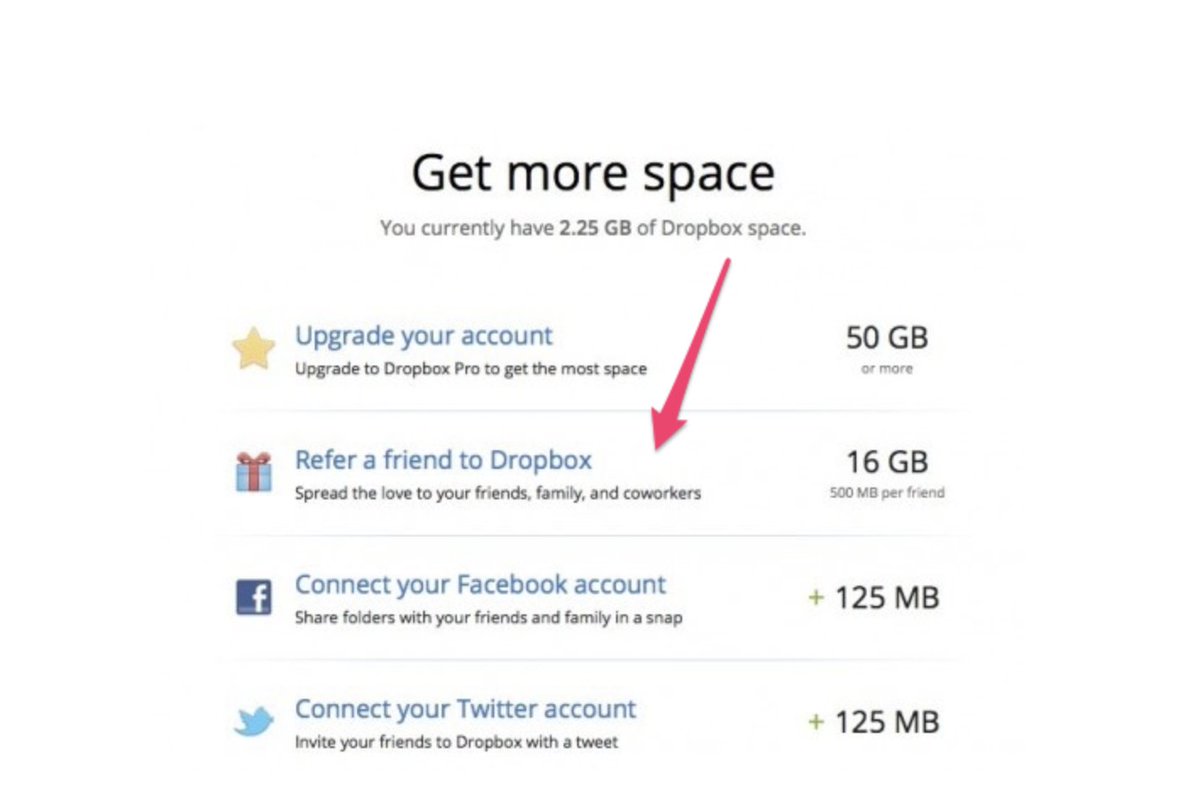
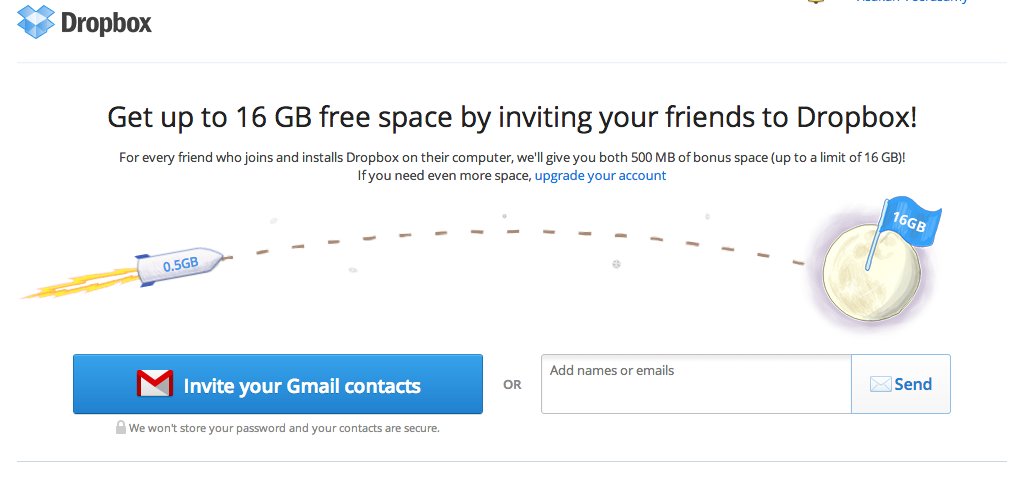
This illustrates the value to the user.
The more friends -- the more space.
The more friends -- the more space.
4. Remove Referral Friction
The more friction a process demands, the fewer amount of people will partake.
To make sure this didn’t happen, Dropbox removed all the friction and confusion of referring a friend.
You just had to click a few buttons.
The more friction a process demands, the fewer amount of people will partake.
To make sure this didn’t happen, Dropbox removed all the friction and confusion of referring a friend.
You just had to click a few buttons.
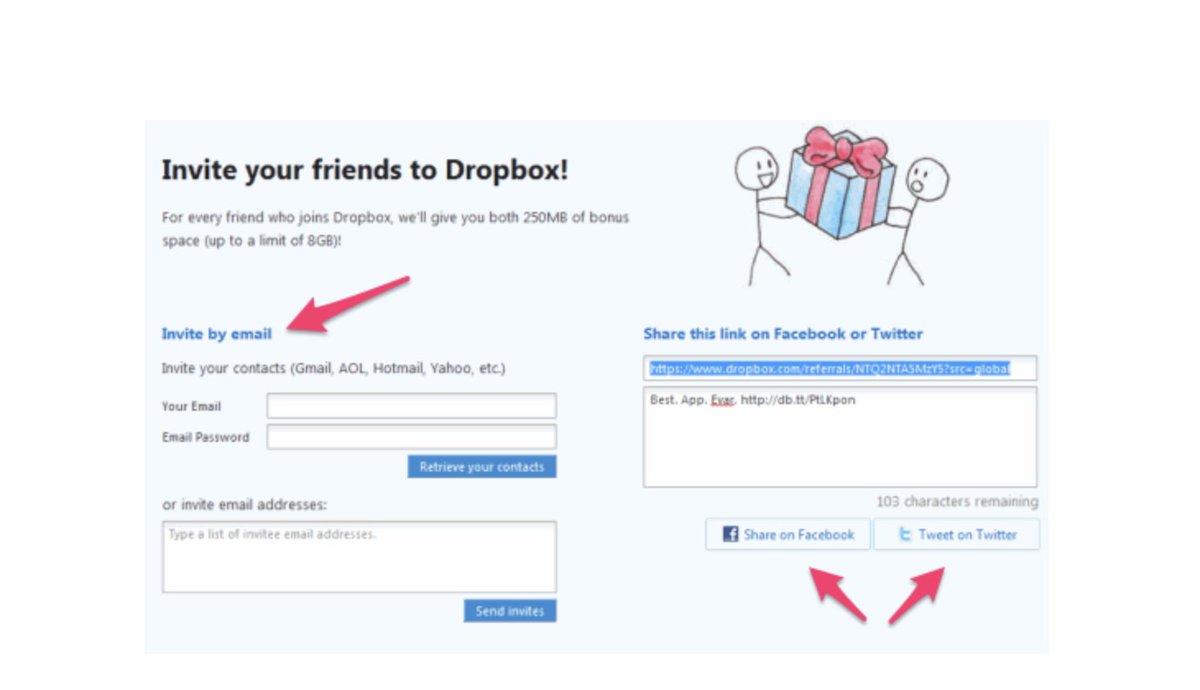
It was easy for you to share on social.
It was easy for you to share via email.
They even helped you sync your contacts so it wouldn’t take you forever.
Dropbox took care of all the hard work so that you can quickly and efficiently send it to your friends.
It was easy for you to share via email.
They even helped you sync your contacts so it wouldn’t take you forever.
Dropbox took care of all the hard work so that you can quickly and efficiently send it to your friends.
5. Show Progress
To make things sweeter, Dropbox added a referral status that was simple to navigate and understand.
Here, users could see how much space they earned, who signed up, and the progress of a referral.
To make things sweeter, Dropbox added a referral status that was simple to navigate and understand.
Here, users could see how much space they earned, who signed up, and the progress of a referral.

The more progress a user sees, the more dopamine will be released.
The more dopamine that's released, the more a user wants to invite more users.
The more dopamine that's released, the more a user wants to invite more users.
6. Continue The Loop With Recursion
This is one of my favorite moves by Dropbox.
Every time you referred a friend and they signed up, Dropbox would send you a “successful referral” email.
It would tell you congrats and about your additional free space.
This is one of my favorite moves by Dropbox.
Every time you referred a friend and they signed up, Dropbox would send you a “successful referral” email.
It would tell you congrats and about your additional free space.
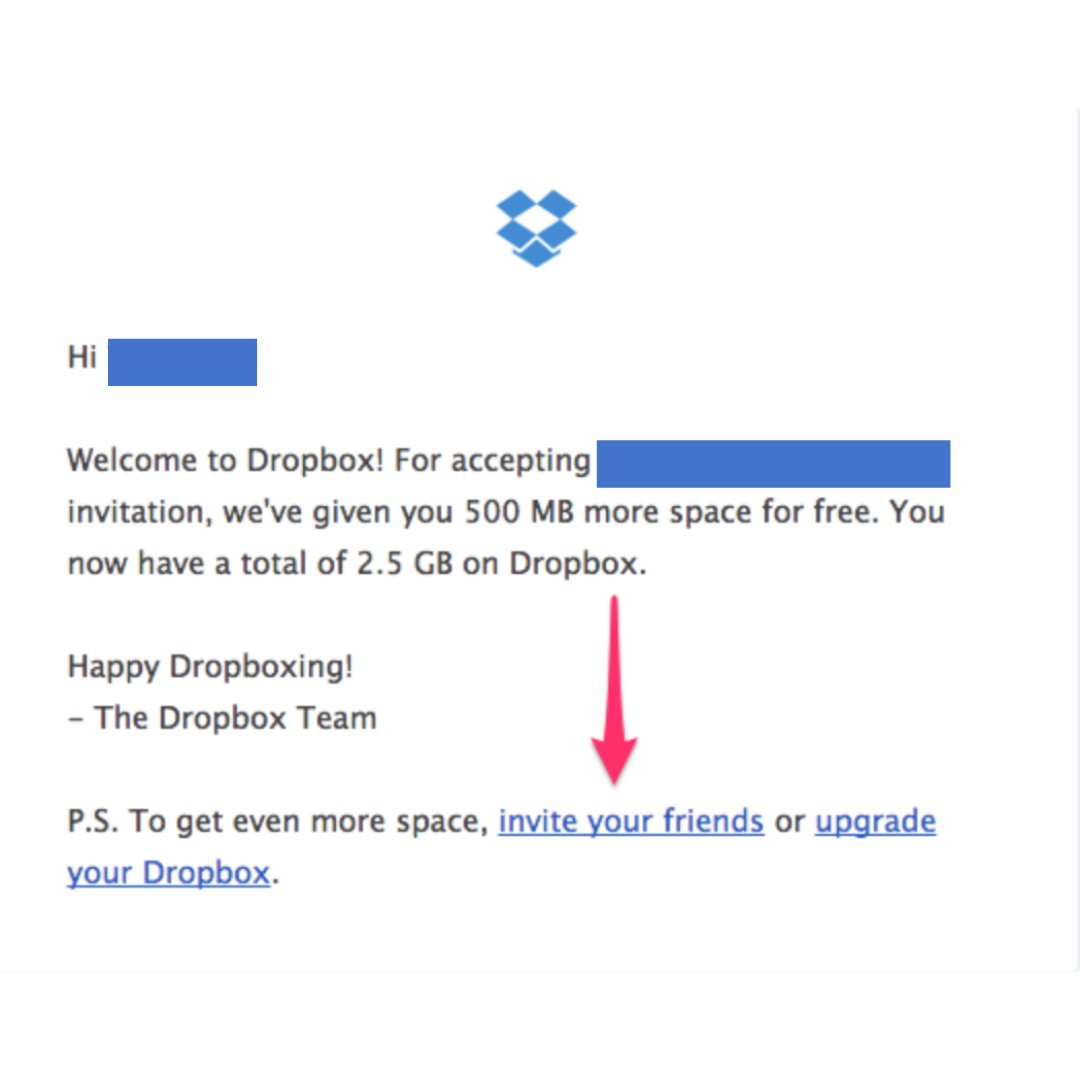
BUT, at the bottom of their email, they’d add a CTA to invite even more friends for more space.
This move starts the growth loop all over again.
GENIUS.
This move starts the growth loop all over again.
GENIUS.
Want more breakdowns and how-tos on your feed? Then make sure to follow @alexgarcia_atx because I'm writing a marketing thread for the next 31 days.
If you rather get it in your inbox, then 👇
bit.ly/3flYp6b
If you rather get it in your inbox, then 👇
bit.ly/3flYp6b
TL;DR
1. Include Referral Program Into Onboarding Process
2. Make it a 2-sided
3. Illustrate the upside
4. Remove referral friction
5. Show progress
6. Continue with loop recursion
1. Include Referral Program Into Onboarding Process
2. Make it a 2-sided
3. Illustrate the upside
4. Remove referral friction
5. Show progress
6. Continue with loop recursion
Here's a breakdown of Dropbox's Viral Acquisition Loop from @andrewchen 
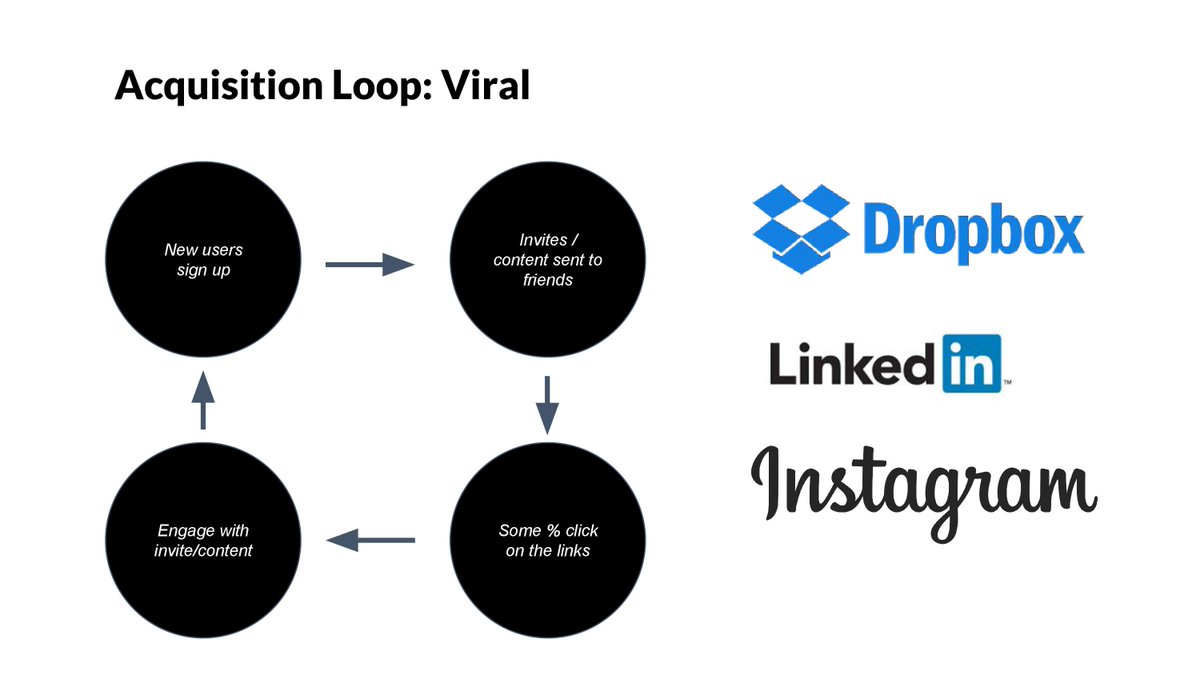
• • •
Missing some Tweet in this thread? You can try to
force a refresh


